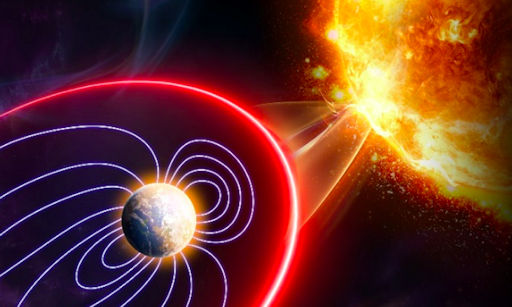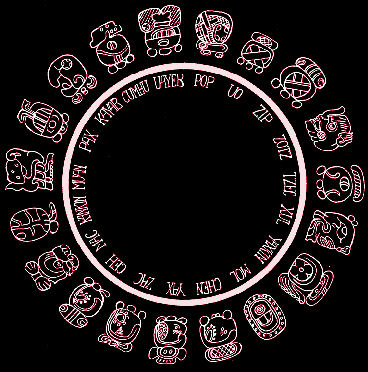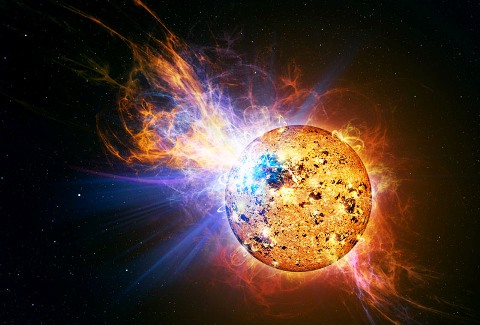
Solar Storms and the Carrington Effect
Put yourself into the mind of a Mayan. You might live a fairly simple life of agricultural subsistence in the rainforests of the Yucatan, but your appreciation of the passage of time is, remarkably, far more complex than any calendar system, before or since.

Image credit: Jing Liu
The Maya’s handy, everyday solar calendar, called the Haab, was made up of eighteen months of twenty days, to which were added five unlucky days, to make a total of 365 days. This provided them with vague, pragmatic value for the solar year. But, dovetailed into this was an additional, sacred calendar, known as the Tzolkin. This comprised of 260 days (the length of time equivalent to the human gestation period, which had been handed down from the earlier Olmecs), divided into twenty weeks of thirteen days each. There was a Mayan god or goddess for each week, and also for each day.

These two calendars intermeshed to form a grand ‘Calendar Round’ of 52 years (roughly approximate to the average human lifespan at the time, one would imagine). Every one of the 18,980 days of this combined calendar was assigned a unique date. It is an amazing system whose origins are shrouded in mystery, but are likely to be astronomical in nature, particularly with regard to the cycles of the planet Venus.
Then things get really complicated! To measure historical time, the Mesoamericans extended their already mind-boggling system of 52 year cycles to create a Long Count. The maths is absurdly complicated, but it is generally accepted that this long period (or Age) began with the Mayan creation date of 11th August 3114BC. Significantly, the end of their “b'ak'tun 13” falls on 21st December 2012.
The potential for some kind of major change to Humanity associated with the Mayan Calendar was first mooted in 1987. A Harmonic Convergence event was promoted by New Age writer Jose Arguelles with great success (1). It seemed to capture the public mood in the USA, and paved the way for thinking about the end of the Mayan Age in 2012. One suspects that the public awareness of 21/12/2012 will be an order of magnitude greater than the Harmonic Convergence of 1987, and will become a defining moment for the global New Age movement.
The End of the Age Approaches
What, if anything, will actually happen on that day, the winter solstice of 2012? Does it mark the end of an Age, with all the apocalyptic repercussions associated with a doom-laden prophecy? The date seems real enough, according to academics studying the Maya and their incredibly complex calendar systems. But the sceptics dispute whether it marks the end of an Age, and point to confusion about its implications among the modern Maya who still make use of the traditional calendar systems.
However, many alternative researchers believe that 21 December 2012 will mark a point in time when humanity experiences a shift to a higher consciousness. Not before time, perhaps, considering the multiple problems our species faces globally. There is great hope that a New Age will usher in greater awareness of our common humanity, and our place in the Cosmos. There are several theories doing the rounds about cosmic alignments, particularly with regard to the galactic core, galactic equator and even that old chestnut, the Precession of the Equinoxes.

Such ideas take on a distinctly astrological tone, where wider human experience and awareness is thought to be tied in with grand cosmic cycles. After all, we are also not far away from the next change of Astrological Age, from Pisces into Aquarius.
The last such change saw the advent of Christianity (alongside a number of other competing End of the Age cults some two thousand years ago), so it seems reasonable to suppose that the appreciation of such an astrological event in the public mind is sufficient in itself to bring forth a new cult, religion, or even, in time, a new calendar, in our post-modern times.
In that context, 21/12/2012 provides us with a potential starting date for a Change of the Age, at least in the wider public perception: A self-fulfilling prophecy, one might say. I feature such thinking in my novel ‘Ezekiel One’, which is set during the final months of 2012 (2).

But there are darker connotations to the 2012 date, too. The ancient Mesoamericans, particularly the Aztecs, were intensely fearful of their gods, and practiced human sacrifice in the belief that this would stave off their wrath. But all the lives sacrificed by the high priests of the Aztecs could not prevent the inevitable, as even the priests themselves believed that the end of fifth world era, or Fifth Sun, would be brought about by great earthquakes, no matter what.
Whilst the Mayans were not quite as blood-thirsty as their Aztec cousins, it seems likely that they too believed in a violent end to the Age. They would, no doubt, have viewed the earthquakes which dogged the early part of 2010 with some trepidation, given its proximity to b'ak'tun 13.
Which begs the question – will 21 December 2012 be marked by a physical catastrophe, possibly of global proportions? This question is the one that impinges most upon my own research area, that of the existence of Planet X. There are many possible means that doom could be wrought, but when one is considering calendars ranging over millennia created by a people whose fascination with the planets and stars is widely accepted, then one cannot rule out the possibility that the Mayan Age is somehow connected with another grand cycle: the return of the planet Nibiru.
The problems arise when trying to figure out what that ‘somehow’ might be. The planet Nibiru, or Planet X as it is otherwise known, is thought to have an orbital period of some 3600 years – a figure which does not sit well with the cogs and wheels that intermingle to create the Mayan system.
There is also not much evidence to suggest that this planet is bearing down upon us as we speak – although you will find many suggestive videos to that effect on YouTube.
Although my own research has led me to believe that there is an undiscovered planet of immense proportions lurking in the outer solar system (which I term ‘The Dark Star’ (3)), it seems much less likely that such an entity might be about to rain doom down upon us, directly at least. It is simply too far away, and moving too slowly, to pose an imminent threat.
A Grand Cycle of the Sun
However, there are other possibilities. One is that the Mayan cycles might fit in with the perihelion transits of major comets, or comet swarms connected with the Dark Star. In other words, that long-period comets of considerable size, and posing some immediate danger, are at this moment moving towards the inner solar system in time for the end of the Mayan Age.
A second possibility is that the Sun itself is somehow tied in with the Mayan Long Count, and exhibits an as-yet unrecognised Grand Cycle, which is due to max out at any time. The Sun is, after all, immensely complex as well, perhaps physically reflecting the complexity underlying the Mayan count of years? Some researchers, like Maurice Cotterell, believe that there is a link. His work proposes a Grand Cycle of about 3740 years, involving a connection between the Sun and the neutral sheet of the solar system. A over-arching cycle attained through his calculations provides us with a figure of 18,139 years (4). What does this relate to? He doesn't say, perhaps because, at the time of writing, he had never been in a position to relate this cycle to the behind-the-scenes machinations of a binary sub-brown dwarf...
Bring this Dark Star to the cosmic table and such cycles become a realistic option. Like two immense magnets, the Sun's field and the Dark Star's field lock horns on a cyclical basis. This provides a new factor to bear in mind when researching the Sun's complex behaviour, over immense time intervals. Perhaps, ancient knowledge of this might explain their fascination, even obsession, with complex calendars - like that of the Maya.

We should not under-estimate the threat. A huge solar storm event would have a dramatic effect on our modern technological world. Scientists are waking up to the possibility that the entire global electrical system might collapse during such an event. The Electric Infrastructure Security Council in the U.S. are alarmed at the possibility of a truly massive solar flare, which would disturb the Earth's magnetic field. According to a spokesman on BBC Radio 4's 'Today' programme (5) the National Academy of Sciences conducted a study of the threat from solar flares, and they found that enormous flares have occurred before modern times, when the infrastructure at risk was not yet in place.
During an immense solar flare event in 1859, the telegraph system at the time was burned out all over the world (due to the "Carrington Effect"). There was talk of people reading at the equator by the light from the aurora. If a solar flare of the same magnitude occurred today it would "destroy our electrical infrastructures" on a global level. Such an event today would be a total disaster for our civilisation.
We would have 12-14 hours of possible warning, and only 20 minutes of definite warning! At the present time, our electrical infrastructure is entirely unshielded from this threat. Imagine a world where everything electrical stops working - lighting, computers, traffic lights, vehicles...everything that helps to make our world modern! It would be a massive catastrophe for our modern world.
But such mayhem could surely not be envisioned by a simple ancient Mayan as he contemplated the cycles of the land and the sky? Could it? Well, astrophysicists have argued that an even more catastrophic solar event occurred around 774AD - 775AD. Of course, there were no telegraph systems to burn out back then, but evidence for such an event takes the form of a 12% rise in the carbon-14 isotope in tree rings. This very significant rise indicates an "extremely energetic event of unknown origin had occurred during that time period" (6).
Astrophysicists Adrian Melott and Brian Thomas (of the University of Kansas and Washburn University respectively) argue that it's possible that, in the absence of a supernova event in recorded history at that time, a solar flare could have caused the anomaly (6). They propose that a solar flare 10 or 20 times the size of the Carrington event of 1859 could well explain the carbon-14 rise of 774AD. Given the problems associated with the Carrington event, it beggars belief what an energetic barrage of 20 times that intensity could cause today!
Furthermore, given that the Classic Mayan civilisation flourished between 250 and 900AD, this more powerful event around 774AD happened at the height of their technological prowess. Were they aware of the event? Did this, and perhaps other previous solar events now lost in the mists of time, shape their knowledge of solar system cycles?
If Maurice Cotterell is right about these Grand Solar Cycles, and I am right to explain this with the elliptical orbit of a binary Dark Star, then it is entirely possible that the Mayan Calendar is a means to warn future generations of an impending immense solar flare event. One thing you can be sure of – we will all find out ourselves soon enough!
Written by Andy Lloyd, 20th September 2010, updated 3rd December 2012
author of 'The Dark Star'
(2005), 'Ezekiel One'
(2009), 'The Followers of
Horus' (2010) and 'Darker Stars' (2019)
Published by Timeless Voyager Press
References:
1) Stephanie South "2012 - Biography of a Time Traveler" New Page Books, 2009
![]() 2012: Biography of a Time Traveler
2012: Biography of a Time Traveler
2) Andy Lloyd "Ezekiel One" Timeless Voyager Press, 2009
3) Andy Lloyd "The Dark Star: The Planet X Evidence" Timeless Voyager Press, 2005
2) Adrian Gilbert and Maurice Cotterell "The Mayan Prophecies: Unlocking the Secrets of a Lost Civilization" 1995
3) BBC Radio 4 'Today' programme, 20 September 2010
4) Bob Yirka "Astrophysicists suggest solar flare could explain carbon-14 bump in AD 774" 29 November 2012